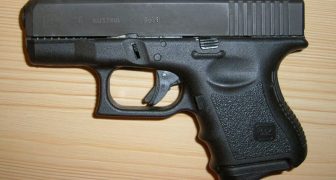Can you use handloads for home defense? – .223 Hornady 55 gr Soft Point
This is a guest post by Andrew Betts
A lot of folks hand load for range use, hunting, emergency preps, and yes, for home defense. Contrary to what certain shills might tell you to generate magazine advertisement revenue, the universe won’t implode if you use a hand load to defend yourself. I know of not one single case where ammunition choice was a factor at trial. That said, not all loads are created equal, so let’s take a look at this particular load and determine whether it is appropriate for defensive use.
The test setup was a Hornady 55 gr SP loaded over 25.4 gr of TAC smokeless powder and fired from 11.5″ and 16″ AR-15 type rifles into calibrated 10% gelatin at a distance of approximately ten feet. A Surefire FA556AR silencer was attached to both rifles.
calibrated 10% gelatin at a distance of approximately ten feet. A Surefire FA556AR silencer was attached to both rifles.
The BB calibration results were 590.5 fps and 3.7″.
The 16” barrel produced an impact velocity of 3,014 fps and penetrated 10.7”. The retained weight was 26.9 gr. Max expansion was 0.425″ and the minimum expansion measurement was 0.335″.
The 11.5” barrel produced an impact velocity of 2,751 fps and penetrated 12.1″. The retained weight was 31.3 gr. Max expansion was 0.410″ and the minimum expansion measurement was 0.350″.
In both cases a very impressive cavity was formed and the experts tell us that a large stretch cavity combined with fragmentation and an impact velocity over 2,000 fps can actually contribute substantially to wounding as the cavity exceeds the elastic limit of the tissue and the fragments exaggerate the wound. That behavior is pretty typical of .223 ammunition when it expands and/or fragments and this particular bullet is no exception. It did a fantastic job, especially considering that this is not a bonded design.
exaggerate the wound. That behavior is pretty typical of .223 ammunition when it expands and/or fragments and this particular bullet is no exception. It did a fantastic job, especially considering that this is not a bonded design.
While the expansion, fragmentation, and wound characteristics were certainly impressive, the penetration was a bit lacking when fired from the 16” barrel. A minimum of 12” of penetration is required to reach vital organs and produce reliable incapacitation in a variety of situations. While 6”-8” might be enough if an attacker were standing still and facing directly at you with his arms at his sides, he also wouldn’t be attacking you if he were doing that. Bullets fired in defense often have to traverse limbs before striking the torso because they are outstretched holding a weapon. Those bullets may also impact the body at an oblique angle because the shooter was forced to fire from a compromised position if he or she was knocked to the ground or tripped or had to fire under or around an obstacle.
The reduced penetration isn’t such bad news, though, because this isn’t a factory load where we are stuck with the muzzle velocity they give us. The results from the 11.5” barrel are encouraging. This bullet would certainly be a good choice for defense at or around 2,700 fps. If one’s home defense rifle is an 11.5” SBR like the author’s, this load is good to go just as it is. If your home defense rifle has a longer barrel, all you’ll have to do to get the performance you need is to dial back the powder charge until you get approximately 2,700 fps muzzle velocity.
defense rifle is an 11.5” SBR like the author’s, this load is good to go just as it is. If your home defense rifle has a longer barrel, all you’ll have to do to get the performance you need is to dial back the powder charge until you get approximately 2,700 fps muzzle velocity.
This is where one of the most powerful benefits of hand loading comes into play. We don’t have to limit ourselves to what is available from the factory. We can tailor a load to achieve exactly the characteristics that we want. Need more penetration? Dial back the velocity and you’ll get less expansion and/or fragmentation and deeper penetration. Need more expansion? Dial up the velocity. We can also select a powder with a burn rate that is appropriate to the barrel length we intend to use and a bullet that’s not merely close, but provides exactly the characteristics we want.
Andrew Betts served with the Arizona National Guard for over 12 years, including a tour to Afghanistan. Visit his YouTube Channel for more great shooting information.Andrew Betts served with the Arizona National Guard for over 12 years, including a tour to Afghanistan. Visit his YouTube Channel for more great shooting information.


Speak Your Mind